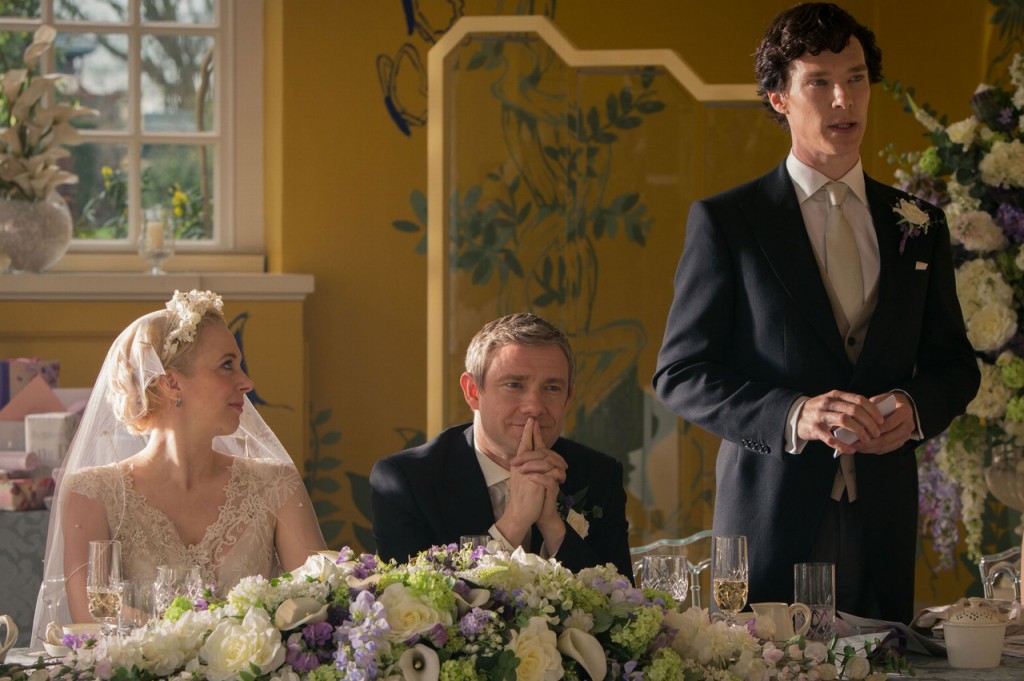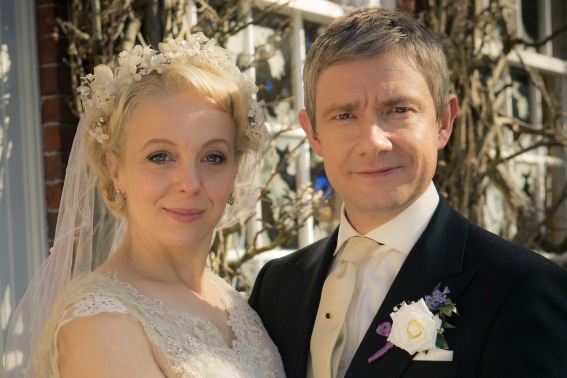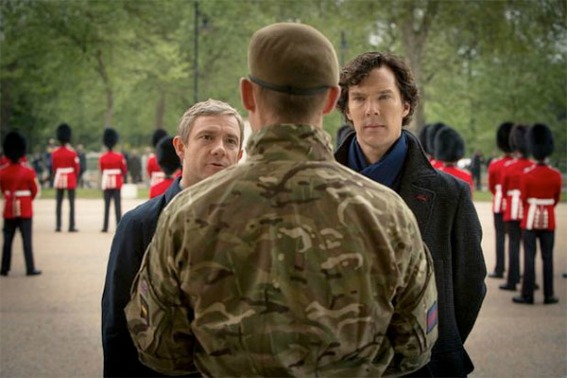Sherlock Review: The Sign Of Three
Trials and Triangles.
The second episode of the third series is also the second episode we experience from Sherlock’s rather than John’s point of view.
Let’s talk a bit of tech first. The visual style is beautiful. We are treated to some very poignant transitions such as Sherlock’s “Into battle” cutting to Major Sholto putting on his dress uniform, and some nice use of SFX to cut between Sherlock’s inner life and what is going on in the outside world. Once again, the show looks more like film than television, and sounds like it too, especially when the score underlines the military themes.
On to storytelling, what this episode illustrates most is that the show is at its best when the writers play fast and loose with the Canon and use references with a light touch to move a story forward, focussing on the character and relationship development, rather than adapting a Victorian mystery one-to-one to modern times, or trying to shoehorn Canon references into every nook and cranny. There are a few issues with the timeline, but given that Arthur “Continuity” Doyle couldn’t even remember Watson’s first name correctly, I can’t really fault the show for that.
What struck me most about the episode is that it is built almost entirely on a subversion of tropes and audience expectations on a number of scales, and starting from Lestrade ordering backup to Baker Street only to be confronted with Sherlock trying to figure out how to write a Best Man speech, it delivers every time: Sherlock is not the worst Best Man in the world, he’s so much the best one it’s scary. The disfigured war hero who looks cast to be the villain of the piece is actually John’s former CO and very good friend. Black Guy Dies First? Not on John Watson’s watch. Actually, nobody dies in this episode – rather a first for the series, and a daring move considering this is a crime show.
At the story’s centre is Sherlock’s Best Man speech at John and Mary’s wedding. Through flashbacks, we get hints at the build-up to the wedding from the moment that John asked Sherlock to be his Best Man, through planning the seating order, right up to the stag night. From what we know about Sherlock, we’d maybe expect him to refuse, or to be the worst Best Man anyone’s ever had the misfortune to choose, but in fact, the opposite happens: he overcompensates and uses his detective skills, his musical abilities, and, apparently, YouTube videos to make the day as nice as possible for Mary and John. Meanwhile, his inbox is bursting, and the criminals of London have to go unpunished. Like John Watson in 3GAR, we are treated this time to a glimpse of a great heart as well as a great brain.
This, of course, brings us to the new factor in this series: Mary Morstan, played to perfection by Amanda Abbington. In the Canon, Mary is not a big character after the conclusion of the case that ends with her engagement to Watson, so credit is due to the screenwriters for handling her character very deftly in this episode. Her interactions with both Sherlock and John are very much in keeping with the Mary Morstan we know from the Canon as someone who is understanding of her husband’s relationship with Sherlock Holmes. The three-way thumbs-up after she has managed to get both of them out on a case is emblematic of the way the three of them function: they are truly a triangle with three sides. In fact, all three of them get to voice the fact that they are with the two people they love most in all the world.
Sherlock displays a degree not just of humanity and awareness of others, but also of self-awareness, in this episode, which is completely unprecedented and, at times, eerie to watch. The Best Man speech is very touching and again subverts our expectations when flips the analogy of the bride and the plain bridesmaid in the opposite of the direction we would expect from the man who called John his “conductor of light” on one occasion. However, there is something quite worryingly off about him – twice, there is “one more deduction I wasn’t expecting”, and he has to physically abuse himself at the wedding when he is trying to determine who the target is. The next episode will hopefully expand on this. The visualisation of his thought process as a court room, with Mycroft as the judge, adds another psychological layer. We also see his deductive process out of order in the “drunk-o-vision” after the failed stag night, and we see him asking for help from Lestrade, Molly, and even Mycroft.
We can’t talk about this episode without talking about John. We do not see through his eyes this time, which means we get a look at him from Sherlock’s point of view, and it is very revealing of both of them. John doesn’t only have a military, but also a medical background, and we finally get to see it put to use beyond a GP surgery, saving two lives in the course of the episode. He assumes a position of authority over everyone in the room, including senior officers and Sherlock, in the case of the bloody guardsman, and he reacts quickly and entirely correctly once he’s heard Sherlock’s call to battle stations at the wedding. Here, at last, is the confident, competent man whom Sherlock Holmes can’t bear to lose.
The resolution of the story is a true team effort between Mary, John and Sherlock and is very satisfying to watch. The denouement leaves us with a bittersweet moment and a final revelation from Sherlock before he leaves the party early.
All told, I have a feeling this episode will be the favourite for many people this time around. The hooks for the next episode are already in place: Mary has received a card from “CAM”, which we can assume to stand for Charles Augustus Magnusson, and it is revealed that she is pregnant. This sets us up for a rather angsty week while we wait for the conclusion – the Canon fate of Mary Morstan was rather unfortunate, after all. For now, however, we are granted an opportunity to marvel at the beauty of equilateral triangles.

Ardy is thirtysomething. Librarian. Transplanted German. Anglophile. Lover of tea and scones (and, yes, jam. I also own ridiculous jumpers).


